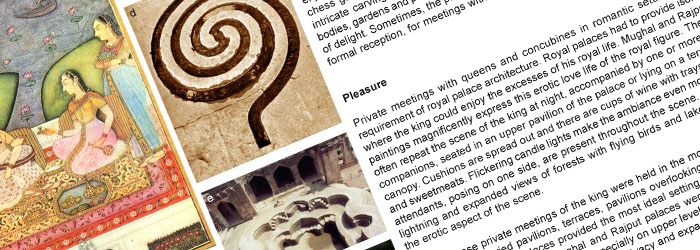Timeless experience: a study of recreational spaces in Indian Palaces
Case studies: Deeg and Jagmandir Palace Complexes, Rajasthan
Undergraduate Thesis, February, 2005
School of Architecture, CEPT University, Ahmedabad
Guide: Prof. Meghal Arya

Preface
‘There is something more than architecture in these palaces, these fanciful pavilions…emblematic of the old-world traditions of their race …every stone is touched with the spirit of romance’ - Percy Brown
Indian palaces, with all their notions of extravagance and royalty, run through the ancient Indian myths and folk-tales. These palaces remain as the surviving representatives of a now vanished civilization. They therefore combine a nostalgic appeal with a more immediate and accessible charm.
At all periods of their history, amongst the finest examples of art have been the palaces built for the security, residence and leisure of the kings, their women and the courts. The palaces reveal the development of a consistent architectural style: palace architecture shows an amalgamation of various indigenous and imported styles.
Royal architecture had to provide suitable settings for private pleasures where monarchs could meet with their queens and concubines. The palaces in this study are considered with palaces in respect to their use for recreation and to the aesthetics and ideals which inform their design.
It is these aspects of spaces that endear them to pleasure palaces that form the focus of this study. Thereupon the study assumes that essence of these spaces is not an elusive quality but achieved by deliberate architectural effect, by devices that are susceptible to analysis.
Aims and Objectives
Palaces for recreation reveal clues to their development: The aim of this study is to analyse these places and determine how the essence of these spaces is manifested architecturally. In order to achieve this, the study asks certain questions which form the objectives of this work:
Tracing the development of recreational spaces in Indian palace architecture:
-What is the role of recreational spaces in Indian Palaces?
Keeping in mind that nature formed an important part of design:
-what are the common architectural features of these spaces?
-what are the basic forms and their spatial characteristics?
-how are forms organized in the whole to generate the necessary experiences?
Scope of the study
For the ease of study, only palaces from the north-western region of India have been discussed. Although certain examples might not be from the same region, they have been chosen for their similar historical and cultural background, thus providing them with a common architectural development. Various regional styles and amalgamations result from this architectural development, stylistic studies are not part of this enquiry.
Case studies
The studies chosen are solely recreational palaces. As a result, the elements and spaces are elaborately developed as compared to other examples. This makes them ideal cases for the study of the essence of recreational qualities in palace architecture.
Method
The study of palaces seeks to present historical data and interpret it in terms of common themes of recreational spaces. The framework of analysis developed from the above focuses on the elemental and organizational principles of pleasure palaces to locate the underlying architectural themes that give these spaces their very essence. However, while the analysis of case studies bases itself on the framework, it also describes spaces on understanding through observation and documentation.
Accordingly, the case studies; Deeg Palace and Jag Mandir Palaces were understood through various visits. Jag Mandir Palace complex formed part of a documentation carried out for purposes of the Documentation cell, Udaipur; by this author.